Dan Barker's Blog, page 13
August 10, 2019
“When did Kay’s Ward get its freedom?”
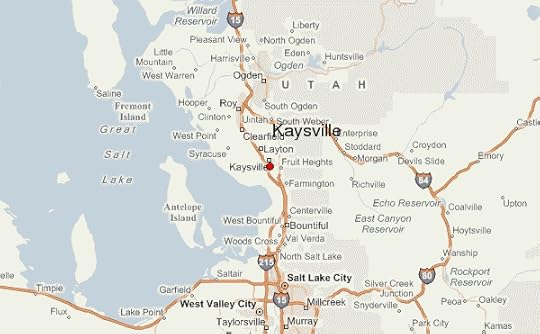 http://w0.fast-meteo.com/locationmaps...
http://w0.fast-meteo.com/locationmaps...In 1856 Bishop Kay was called on a settlement mission. He was the Bishop over the community named for him. After he left, the residents proposed to change the name of the community to Freedom, which prompted which general authority to state, “when did Kay’s Ward get its freedom?a. Brigham Youngb. Heber C. Kimballc. George A. Smithd. Joseph F. SmithYesterday’s answer:A Independence, MissouriMissourians fears seemed substantiated by the contents of the Mormon newspaper printed in Independence—the Evening and the Morning Star. To what extent non-Mormon residents read the newspaper is unknown. However, no other newspaper was being published within 120 miles, suggesting that local non-Mormons either read the Star or went without. The Star not only published revelations commanding the Saints to gather to Zion but also gave instructions on how to do so. In addition, articles informed readers about the numbers of Mormons planning to migrate to Jackson County. An article in the July 1832 issue advised readers that “churches of fifty or a hundred souls each, are coming to the land of Zion from different parts of the nation.” Another issue announced that “many branches of this church. . . in Missouri, Illinois, Indiana, Ohio, Virginia, Pennsylvania, New York, Vermont, New Hampshire, Massachusetts, Maine and Canada . . . will come up this season” to Zion. Mormons not only anticipated that converts from the state would gather to Jackson County but also, according to one article, the gospel “is to be preached to every nation on the globe so that some may be gathered out of every kindred, tongue and people, and be brought to Zion. “Thus the gathering entailed not only those in the states but foreigners out of every country. It must have been especially disconcerting for non-Mormons to read in July 1833 that, despite the twelve hundred Mormons then living in Jackson County, the gathering has continued slowly.”Matthew B. Lund, A Society of Like-Minded Men: American Localism and The Mormon Expulsion From Jackson County, Journal of Mormon History, Summer 2014, 180.
Published on August 10, 2019 03:30
August 9, 2019
The LDS Newspaper was the Only Newspaper
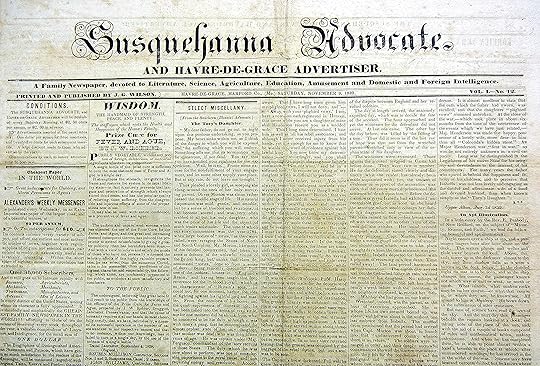 https://hdg1812.files.wordpress.com/2...
https://hdg1812.files.wordpress.com/2...At what location did the non-Mormon population only have a LDS newspaper to read (1830s) since there was no other newspaper within 120 miles?a. Independence, Missourib. Palmyra, New Yorkc. Kirtland, Ohiod. Salt Lake CityYesterday’s answer:B BaseballThe successful first season of the Western Province Baseball Association and the Cumorah Baseball Club would lead to nearly twenty years of Mormon involvement in the sport in South Africa. During that inaugural season the game of baseball became an attractive alternative to the more popular sports such as rugby, cricket, and football (soccer). As the Cape Times sports editor concluded about a particularly entertaining game between the Cumorah’s and Nomads, “The sport will undoubtedly become popular. It deserves to!” And in fact, during the 1930s, baseball became an exciting new sport to follow, and the Mormon missionaries of Cumorah played a large part in its acceptance.Booker T. Alston, The Cumorah Baseball Club: Mormon Missionaries and Baseball in South Africa, Journal of Mormon History, Summer 2014, 109.
Published on August 09, 2019 03:30
August 8, 2019
Popularizing a Sport
 https://i.ytimg.com/vi/6gL5DoE_4Ss/ma...
https://i.ytimg.com/vi/6gL5DoE_4Ss/ma...What sport did the LDS missionaries popularize in South Africa during the 1930s?a. Basketballb. Baseballc. Footballd. HockeyYesterday’s answer:C Made it so Mormon Elders could conduct LDS funeralsFrom the life of Frederik Ferdinand Samuelsen: In 1900 Bro. Samuelsen was chosen as a member of the city council in Aarhus (the second city in point of population in Denmark), which position he held continuously for seventeen and a half years. In 1906 he was elected a member of the Danish Rigsdag and was elected repeatedly after that with ever increasing majorities, notwithstanding strong opposition on the part of the Lutheran clergy, who insisted that it was a disgrace to the country that a “Mormon” should occupy a seat in the Danish Rigsdag, a position which was not held by any “Mormon” in any other country outside of the United States. Brother Samuelsen occupied his position in the Rigsdag until 1918. During the many years that he served in the Rigsdag he took advantage of every opportunity which presented itself to testify to the truth of “Mormonism” in the higher circles of Denmark. When a new law was being enacted in 1908, regulating the rules for conducting funerals, he succeeded in obtaining permission for “Mormon” Elders to conduct funerals for their own people and occupy the chapels used for that purpose, the same as the Lutheran clergy. When an attempt was made in 1912 to forbid “Mormon” Elders carrying on propaganda is Scandinavia, Elder Samuelsen took a bold stand in the Danish Rigsdag, protesting such a move, and declared that during the twenty years he had been a member of the “Mormon” Church he had associated with hundreds of “Mormon” missionaries, all of whom he knew possessed the best and noblest character, being universally known for their honesty and intelligence. The Church minister (Kirkeminister) gave a favorable decision, but felt humiliated to think that not one of the seven Lutheran priests who served in the Danish Rigsdag had opened his mouth in opposition to Samuelsen when he called the “Mormon” Elders good and honorable men. In 1913 Elder Samuelsen again had occasion to defend the “Mormon” missionaries when they were falsely accused of siding the so-called “white slavery.” He called boldly for even a single proof in connection with the accusations, but none such was forthcoming. It ended with a declaration from the king’s cabinet that the accusation against the “Mormons” was entirely unfounded. When in 1914 a certain high official (Herredsfoged) in Jutland forbid two “Mormon” missionaries to hold one of their usual religious services, Elder Samuelsen referred the case to the minister of justice, which led to that official receiving a severe reprimand for having interfered with religious liberty. During the time of the World War Brother Samuelsen found it necessary on many occasions to use his influence with the king’s cabinet in obtaining permission for Norwegian and Swedish missionaries belonging to the “Mormon” Church to visit their relatives in Denmark. When the Elders from Utah were called home, owing to war conditions, Brother Samuelsen was called as a local Elder to preside over the Aarhus conference, which position he held for about eight months, during which time he visited the different branches in the conference repeatedly. He held this position until he emigrated in May, 1919.Andrew Jensen, LDS Biographical Encyclopedia, (Salt Lake City: Western Epics, 1971), 3: 707-708.
Published on August 08, 2019 03:30
August 7, 2019
Regulating the Rules
 http://www.en.ses.aau.dk/digitalAsset...
http://www.en.ses.aau.dk/digitalAsset...As a Mormon on the Danish Rigstag, what law was Brother Fredrik Ferdinand Samuelsen able to regulate in favor of the LDS church in 1908?a. Legalize polygamyb. Stopped the taxing of tithing moneyc. Made it so Mormon Elders could conduct LDS funeralsd. The LDS church could build its own chapelsYesterday’s answer:A One Bishop called to preside over the entire stakeFrom the life of Erastus Bingham: In the spring of 1851 he located on a parcel of land northwest of Farr’s Fort this new location was afterwards called Bingham’s Fort in his honor, but is now called Lynne. Brother Bingham continued as Bishop discharging his duties to the best of his ability, and to the satisfaction of the authorities of the Church until the fall of 1868, when all the Bishops of Weber county were released, except Chauncey W. West, who at the time was chosen Bishop of the whole Stake. Andrew Jensen, LDS Biographical Encyclopedia, (Salt Lake City: Western Epics, 1971), 3: 601.
Published on August 07, 2019 03:30
August 6, 2019
A Surprising Change in Weber County
 https://st.depositphotos.com/1005979/...
https://st.depositphotos.com/1005979/...What change did the church make in Weber county in 1868 that lifted more than a few eyebrows?a. One bishop called to preside over the entire stakeb. Three stake presidents called to preside over the entire stakec. One Relief Society president called to preside over the entire staked. One Elders Quorum President called to preside over the entire stakeYesterday’s answer:C A dreamFrom the life of Adolph Mosiah Nielsen: His mother was one of the first converts to “Mormonism” in Norway. She taught her son the true gospel in his early youth, but, like many other young boys, he was not in a hurry to embrace it, until the Lord in a remarkable dream showed him the necessity of being baptized. In his dream he thought he was in a most beautiful hall where his mother and many other Saints were enjoying themselves, while he stood by the door, not being allowed to participate. Then he thought the Saviour appeared in the hall as a most beautiful personage and spoke to the people in a mild way, though with a clear voice, commending them for their faithfulness on earth while passing through much tribulation. Soon a messenger approached Bro. Nielsen and told him to hurry down to the earth where he should find someone to baptize him. After that he attended meetings frequently with his mother. Andrew Jensen, LDS Biographical Encyclopedia, (Salt Lake City: Western Epics, 1971), 3: 470.
Published on August 06, 2019 03:30
August 5, 2019
It’s What Convinced Him
 http://grist.files.wordpress.com/2014...
http://grist.files.wordpress.com/2014...What was it that finally convinced Adolph Mosiah Nielsen to listen to his mother and attend church?a. His Bishopb. The Eldersc. A dreamd. His FatherYesterday’s answer:B The Elders told her about himFrom the life of Sarah De Arman Pea Rich: After joining the Church, her father began making arrangements for migrating to Missouri. The Elders frequently visited the family and left Church publications in the house to be read by members of the household. In one of these she saw the name of Chas. C. Rich and laughingly said: “This is a very rich name I think I will marry him.” On one of his visits Bro. Greene said” “Sister Sarah I have recommended you to a very worthy young Elder as a companion (Chas. C. Rich). After this another Elder told her the same thing. Soon afterwards she received a letter from Bro. Rich himself in which he asked for her hand in marriage. They had never seen each other and before giving her answer to Bro. Rich she looked into her Bible, when her eyes suddenly fell upon the words of Ruth to Boaz, upon which she answered his letter. The correspondence continued until the family moved to Missouri in the fall of 1837, and Sarah D. was married to Chas. C. Rich Feb. 11, 1838, Geo. M. Hinkle performing the ceremony at Far West. Andrew Jensen, LDS Biographical Encyclopedia, (Salt Lake City: Western Epics, 1971), 3: 208.
Published on August 05, 2019 03:30
August 4, 2019
Where she first Learned of Her Future Husband
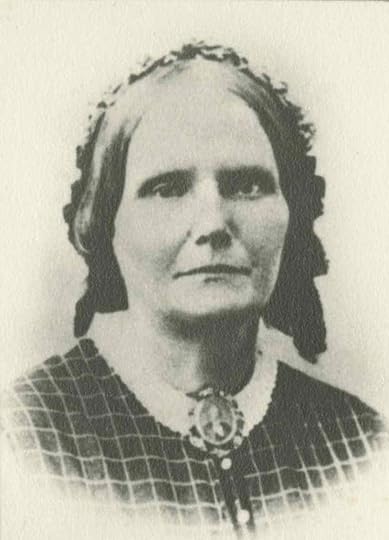 Sarah Pea Richhttps://content.ldschurch.org/overlan...
Sarah Pea Richhttps://content.ldschurch.org/overlan...How did Sarah Pea first learn of her future husband in the mid 1830’s?a. In a church publicationb. The elders told her about himc. At a baptismd. While working on the Kirtland TempleYesterday’s answer:B A festival was held for herFrom the life of Mary Pearce Ballantyne: Mary, a devout Methodist, was on her way to services one Sunday when she was attracted to a Latter-day Saint handbill. Stopping, she offered a prayer for light and guidance and was impressed to go to the meeting of the Latter-day Saints. When Elder George Clark spoke at that meeting, Mary felt every word uttered was meant for her. She was baptized in the River Thames, February, 19, 1849, when a thick ice on the river had to be broken to perform the ordinance. A festival was given in her honor and money was raised for her trip to Zion. Mary would tell of how the cholera plagued wagon train ahead of them had borrowed Edward Stevenson, a friend of her fathers, to replace ill teamsters. He was lent with the promise that the train would have no more cholera, and the promise was kept. She also loved to tell of her most amazing venture into the chasm at Devils Gate on the Sweetwater. Others turned back when the swift water and cliffs seemed to formidable, but Mary determined to finish the feat. She reached a point where she could go no further nor dared go back. At that point a man appeared, lifted her down and told her that the wagon train was a short distance ahead, then suddenly and mysteriously he disappeared. International Society Daughters of Utah Pioneers, Pioneer Women of Faith and Fortitude, (Publishers Press, 1998), 1: 145-146.
Published on August 04, 2019 03:30
August 3, 2019
The Money for Zion
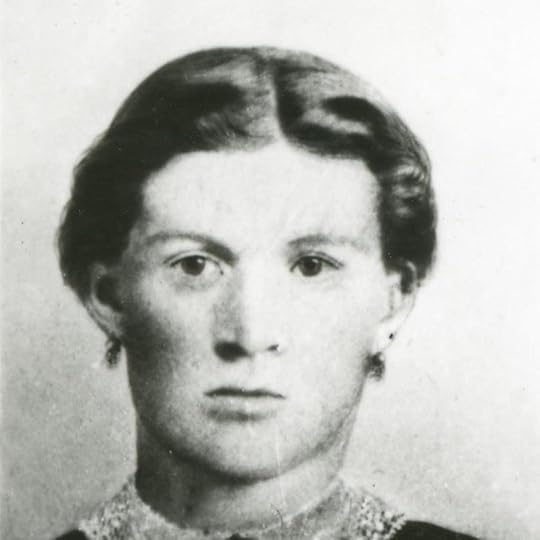 Mary Pearce Ballantynehttps://content.ldschurch.org/overlan...
Mary Pearce Ballantynehttps://content.ldschurch.org/overlan...How was Mary Pearce Ballantyne able to earn money to migrate to America after she joined the church in England in 1849?a. Selling belongingsb. A festival was held for herc. Cleaning homesd. Cooking for the missionaries Yesterday’s answer:B Stole food for themFrom the life of Else Margretha Poulsen Larsen Anderson: Else Margretha was almost five years old when she left her home in Denmark with her parents who had been converted to the Church of Jesus Christ of Latter-day Saints. They traveled on to Liverpool where her grandmother because so ill, the parents sent six year old Else and seven year old Paul on their scheduled sailing vessel, “Jesse Munn,” with a woman who had promised to look out for the children. They were not cared for and would have starved if it had not been for a stowaway boy who stole food for them.The children waited many weeks in Kansas City for their parents to arrive. Finally, the parents arrived and the family began the trek across the Plains in the Hans Peter Olsen Wagon Company. Else fell from the wagon seat and the wagon passed diagonally across her chest. She had to walk the remainder of the trek. Their company arrived in Salt Lake Valley, October, 1854.International Society Daughters of Utah Pioneers, Pioneer Women of Faith and Fortitude, (Publishers Press, 1998), 1: 79.
Published on August 03, 2019 03:30
August 2, 2019
The Stowaway
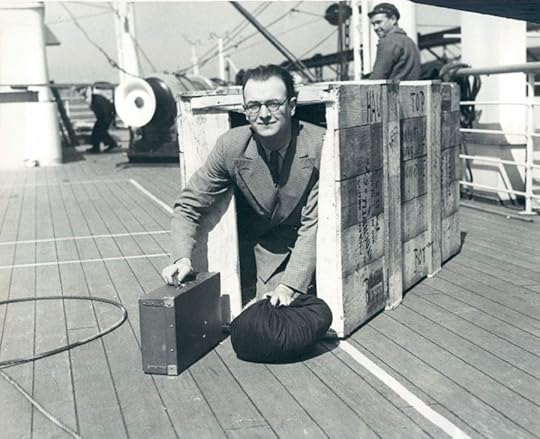 http://stuffnobodycaresabout.com/wp-c...
http://stuffnobodycaresabout.com/wp-c...It’s because of a stowaway that six-year-old Else and her seven-year-old brother, Paul made it to America. What did the stowaway do for the children?a. Gave them a Book of Mormonb. Stole food for themc. Snuck them onto the shipd. Gave them his ticketsYesterday’s answer:C A baptism for healingFrom the life of Mary Ann Hamilton Alder: The Alder family, Mary Ann and George and their daughter, set sail from Liverpool, England, March 5, 1844, for the United States on the ship, “Glasco.” They were on the ocean six weeks before they finally landed in New Orleans. From there they sailed up the Mississippi River to St. Louis and then to Nauvoo.While in St. Louis, Mary Ann was walking along the sidewalk, when suddenly a tornado overtook her. A building fell and Mary Ann was caught in the debris. She received a cut on the side of her head an eighth of an inch from her brain, and her legs were broken. A doctor was found and he didn’t set her legs well because he didn’t think she would live until the morning. Mary Ann knew there were Elders in that locality and asked to have them come. The Elders came and administered to her. When the doctor came back the next day, she was still alive. The doctor wanted to break her legs to set them again but her husband, George, would not let them. Mary Ann recovered but used crutches until she was baptized, March 18, 1851. She dropped the crutches on the bank of a river and she was helped into the water. After the baptism was performed, she walked out of the water and never used her crutches again.International Society Daughters of Utah Pioneers, Pioneer Women of Faith and Fortitude, (Publishers Press, 1998), 1:27.
Published on August 02, 2019 03:30
August 1, 2019
What the Doctor Couldn’t Do
 https://quotefancy.com/media/wallpape...
https://quotefancy.com/media/wallpape...As Sister Alder was walking on a street in St. Louis in 1844 a tornado hit. The debris from a falling building broke both her legs. A doctor couldn’t heal her, but what did?a. A blessing from the Eldersb. Attending the Nauvoo Templec. A baptism for healingd. Reading the Book of MormonYesterday’s answer:D Wearing the fashions of the worldTemple attendance also played an ever-greater role in moral behavior and sexual conduct. “Don’t give recommends to the unworthy,” said Elder George Teasdale. Even in matters of fashion choice, temples had an influence. “Do not come to the temple with the fashion of the world on you,” Said John D. T. McAllister in St. George. And by the late 1880s, adherence to the Word of Wisdom—abstaining from tobacco, liquor, and hot drinks—was becoming part of temple recommend interviews. The point is that increased temple attendance imposed a reformation of behavior among thousands of believing Mormons anxious to do their part in redeeming the dead. Tithing, the Word of Wisdom, personal purity, and other expressions of obedience and worthiness played out upon the everyday lives of thousands of men and women who previously had not been so challenged. Recurring temple attendance would now accomplish what the Mormon Reformation had set out to do some twenty years before. “Which is the Wisest Course,” The Transformation in Mormon Temple Consciousness, 1870-1898. Richard E. Bennett, BYU Studies Vol. 52, No. 2, 2013, 25-26.
Published on August 01, 2019 03:30



